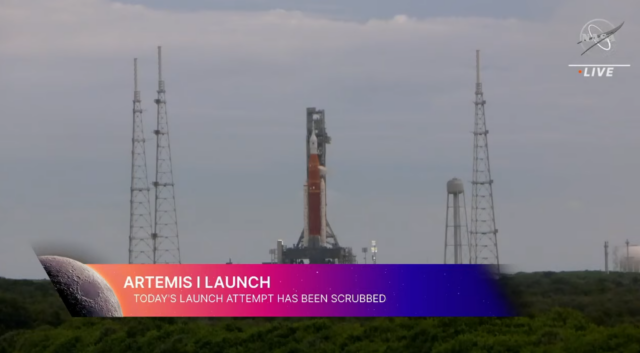NASA Targets Saturday for Artemis 1 Launch

NASA has moved the launch of their Space Launch System (SLS) moon rocket to this Saturday, after problems during the countdown to Monday’s Artemis 1 launch attempt. Previously, the agency had given Sept. 2 and Sept. 5 as backup dates and late summer weather in Florida is no joke. Five separate lightning strikes on Pad 39B on last Saturday alone gave the agency pause. But the weather isn’t the problem here. NASA is chasing a ghost in the SLS rocket’s hydrogen system.
The Space Launch System’s four RS-25 engines require ultra-cold liquid hydrogen, around -420° F. It’s so cold that launch controllers have to thermally condition the engines during countdown, pre-cooling them by trickling just a bit of that ultra-cold hydrogen through them so that they don’t warp or crack on contact with the cryofuel. NASA calls this an “engine bleed” because they’re bleeding off hydrogen from the rocket’s fuel tank into its engine. Flight control scrubbed Monday’s Artemis 1 launch before takeoff because during the engine bleed phase, Engine 3 reported that its temperature was too high. Had they gone forward with the launch, the engine itself could have been damaged or destroyed. Best case, that would result in yet another delay. In the worst case, the rocket’s fuel tank could undergo a catastrophic explosion.

NASA scrubbed its Artemis 1 launch attempt on Monday, Aug. 29, after encountering difficulties with an ‘engine bleed’ test of its hydrogen fuel systems.
Flight controllers halted the first Artemis 1 launch countdown after the team couldn’t verify that all four of the SLS rocket’s engines were cold enough to tolerate the hydrogen fuel. Mission engineers aren’t certain whether the rocket’s engines actually didn’t get cold enough, because it could be a broken temperature sensor at fault. But at a Tuesday evening news conference, SLS program manager John Honeycutt said, “The way the sensor is behaving does not line up with the physics of the situation.”
Close Enough for Government Work
It’s hard to explain how obnoxious it is to work with hydrogen. Imagine the child of Whac-a-Mole and Sterling Archer: escaping just when you think you’ve got them dead to rights, and leaving chaos and destruction in their wake. It’s not as bad as antimatter, but it’s close. Hydrogen hates confinement. Chill it enough to make it a liquid, and it will creep up the walls of its container in defiance of gravity and reason. Take off the pressure for an instant, and it evaporates on the spot. If you manage to keep liquid hydrogen in a tank, it can physically damage the metal and destroy the tank itself — and manufacturing tolerances mean next to nothing when the hydrogen will weasel its way between the tank’s atoms, without so much as an apology on its way out.

NASA’s Artemis 1 mission is the first integrated test of the agency’s deep space exploration systems: the Orion spacecraft, SLS rocket, and supporting ground systems. And it’s definitely going to space. Real soon now. Image credit: NASA/Joel Kowsky
Hydrogen-oxygen rockets are the most fuel-efficient, in terms of how much fuel you need to send a given mass of rocket to space. However, of all the types of rocket fuel we use, hydrogen is also the most technically complex. Of course, the US government used hydrogen for its gigantic Congressionally-mandated cost-plus rocket. Of course they did. But it didn’t have to be this way.
You know what Soyuz uses? Kerosene.
For Artemis, Saturday May Be Too Soon
Currently, NASA’s plan is to give it another go this Saturday. Mission managers decided Tuesday to bump the chilldown test earlier in the launch countdown. In theory, that will give them enough time to get it right.
NASA has been going ham on the hype machine for the Artemis 1 launch, but the space news circuit has been somewhat more reserved. NASA is almost synonymous with exhaustive rehearsals and contingency plans. Even so, the agency has never completed a successful fueling test of its SLS rocket. All four ‘wet dress’ rehearsals went awry, because of a problem somewhere in the rocket’s hydrogen systems. Worse, to get through the fourth, NASA had to fool the flight computer. Had they not tricked the computer into ignoring a problem, they might have gotten far enough into their testing to discover the engine temperature issue.
Cheating on your homework only makes sure you won’t know what to do on the test. Nevertheless, after the launch scrubbed on Monday, NASA’s chief of human exploration systems development, Jim Free, insisted that “We felt, and still feel, like going for today was the right thing to do.” And I’m sure the agency also feels, at least on paper, like Saturday is a fine time frame for the Artemis launch.
Stand back from the pad, is all I’m saying. Somewhere around Orlando might be far enough.

Comments are closed.